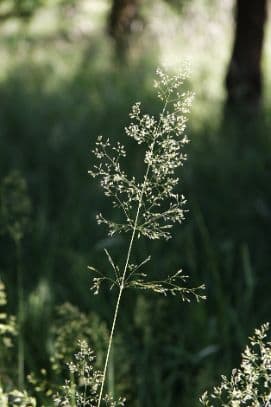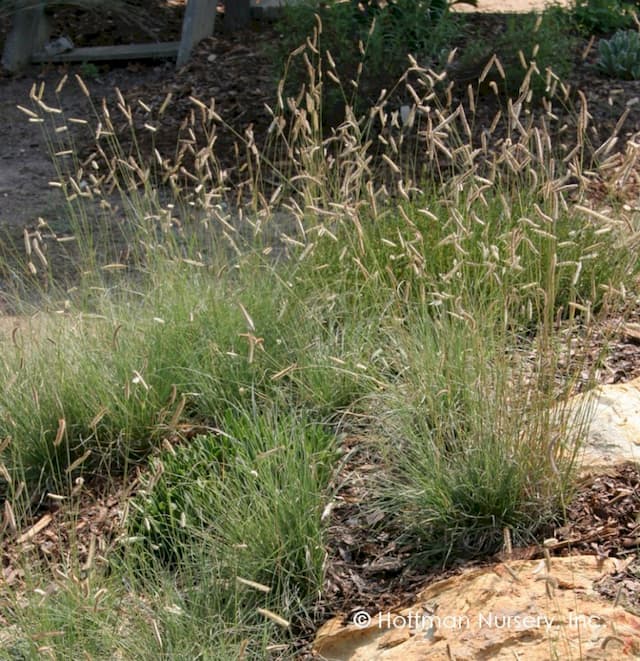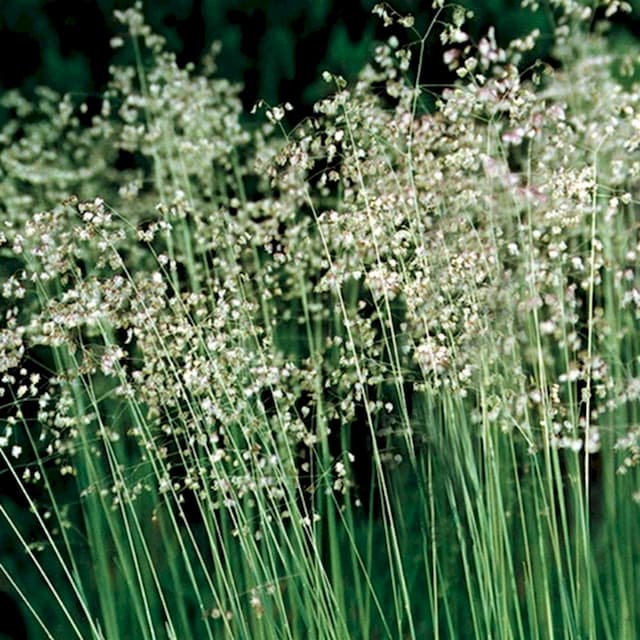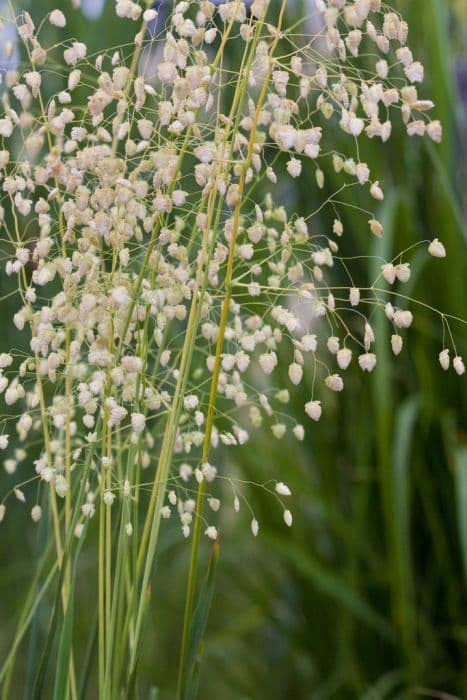Hare's Tail Grass Lagurus ovatus

ABOUT
Commonly known as Hare's Tail grass, this charming plant is easily recognizable for its unique and fluffy flower heads that resemble the puffy tail of a hare. The soft and woolly flower spikes emerge from a tuft of slender, blade-like leaves, forming a dense clump with an overall tufted appearance. The leaves are usually a blue-green or gray-green shade, adding to the plant's soft color palette. The flowers start as a pale green hue and mature into an off-white or sometimes a creamy tan color as they age throughout the season. These flower heads are comprised of numerous tiny flowers densely packed together, giving them a fuzzy texture that's particularly striking when caught in the sunlight. Hare's Tail grass is adored for its whimsical and delicate structure, making it a favorite in dried floral arrangements and cottage-style gardens. Its gentle movement in the breeze adds an element of liveliness to the landscape. The plant typically remains attractive throughout the growing season, with the flower heads maintaining interest even as they dry out and become more brittle later in the year. Overall, this petite and ornamental grass is celebrated for its distinctive appearance and ability to add softness and whimsy to any setting where it is grown.
About this plant
 Names
NamesFamily
Poaceae
Synonyms
Hare's Tail Grass, Bunny Tails, Bunny Tail Grass, Lagurus Grass
Common names
Lagurus ovatus var. hirsuta, Lagurus hirsutus, Lagurus ovatus var. villosus, Lagurus villosus.
 Toxicity
ToxicityTo humans
The plant commonly known as bunny tail grass, Lagurus ovatus, is not known to be toxic to humans. There are no widespread reports of poisoning or toxic reactions from ingestion or contact with this plant. Therefore, incidental contact or ingestion is unlikely to cause harm. However, it is always advisable to exercise caution and avoid ingesting plants that are not specifically grown for food purposes.
To pets
The plant commonly known as bunny tail grass, Lagurus ovatus, is also not known to be toxic to pets. Like with humans, there are no major reports of toxicity or dangerous side effects in pets upon ingestion or contact with this plant. While bunny tail grass is not considered poisonous to pets, it is always prudent to monitor your pets and prevent them from eating large quantities of any non-food plant, as it could potentially cause gastrointestinal upset or an obstruction.
 Characteristics
CharacteristicsLife cycle
Annuals
Foliage type
Deciduous
Color of leaves
Green
Height
1 foot (30 cm)
Spread
1 foot (30 cm)
Plant type
Herb
Hardiness zones
8
Native area
Mediterranean
Benefits
 General Benefits
General Benefits- Erosion Control: Lagurus ovatus, commonly known as bunny tail grass, has a dense root system that helps stabilize soil and prevent erosion.
- Ornamental Value: Bunny tail grass is valued for its unique, fluffy seedheads which add texture and interest to gardens and flower arrangements.
- Drought Tolerance: Once established, bunny tail grass is highly tolerant of drought, making it suitable for xeriscaping or low-water gardens.
- Wildlife Habitat: The dense foliage provides shelter for small animals and insects, while its seeds are a food source for birds.
- Low Maintenance: Bunny tail grass requires minimal care once established, making it an excellent choice for low-maintenance landscapes.
- Soil Improvement: When used as a cover crop, bunny tail grass can contribute to soil health by adding organic matter as it decomposes.
- Seasonal Interest: With its attractive summer blooms and seed heads that last into winter, bunny tail grass provides visual interest throughout multiple seasons.
 Medical Properties
Medical PropertiesThis plant is not used for medical purposes.
 Air-purifying Qualities
Air-purifying QualitiesThis plant is not specifically known for air purifying qualities.
 Other Uses
Other Uses- Lagurus ovatus, also known as hares tail grass, is often utilized in dried flower arrangements for its unique fluffy seed heads that maintain their shape and color for long periods.
- The grass can be used as a filler in bouquets to add texture and a soft, whimsical touch, making it a favorite among florists and DIY brides.
- It can serve as an excellent material for crafting, such as creating homemade paper or adding a natural element to handmade cards or scrapbooks.
- Hares tail grass is used in landscape design to provide contrast in rock gardens or xeriscaping due to its drought tolerance and ornamental appeal.
- The seeds of the plant are sometimes used in traditional arts and crafts, such as in the creation of natural jewelry or decorations.
- As a natural dye source, parts of the plant can be boiled to extract colors for dyeing fabric or yarn.
- The dense clumps formed by the grass can provide shelter and cover for small beneficial insects and wildlife in gardens.
- Some artisans may use the stiff stems in the creation of miniature models or structures, taking advantage of their structural integrity when dry.
- Lagurus ovatus is also incorporated into educational activities, teaching children about plant life cycles and seed dispersal due to its easily observed growth stages.
- It may also be used as a tactile element in sensory gardens, providing an interesting texture for visitors to touch and experience.
Interesting Facts
 Feng Shui
Feng ShuiBunny tail grass is not used in Feng Shui practice.
 Zodiac Sign Compitability
Zodiac Sign CompitabilityBunny tail grass is not used in astrology practice.
 Plant Symbolism
Plant Symbolism- Softness: Known as bunny tail grass, its soft, fluffy appearance is reminiscent of a tender and gentle touch, evoking feelings of comfort and delicacy.
- Fertility: The genus name Lagurus is derived from the Greek words 'lagos' (meaning hare) and 'oura' (meaning tail), indicating its association with rabbits, which are often symbols of fertility and abundance.
- Playfulness: The playful form and movement of the grass in the wind mirror a light-hearted and whimsical energy, often inspiring joy and fun.
- Peace and Tranquility: Bunny tail grass with its soft texture and soothing appearance can also be symbolic of peace and the need for a calm and tranquil environment.
- Craft and Creativity: Often used in dried floral arrangements and crafts, it represents creativity and the homemade, celebrating handcrafted artistry and design.
 Water
WaterThe bunny tail grass, or Lagurus ovatus, prefers a watering regimen that allows the soil to dry out slightly between watering sessions. It's important to water deeply, ensuring the water reaches the root zone so that shallow, weak root development can be discouraged. Water bunny tail grass with approximately one inch of water every week during the growing season, adjusting for rainfall accordingly to prevent overwatering. During the dormancy period in the colder months, reduce the frequency to about half an inch every two to three weeks, depending on the plant's location and the humidity of your climate.
 Light
LightBunny tail grass thrives best in full sun conditions, receiving at least six hours of direct sunlight daily. Positioning it in a spot without any shade is ideal. However, it can tolerate some light shade but flowering may not be as abundant. Good light exposure is critical for the healthy growth and development of its signature fluffy seed heads.
 Temperature
TemperatureBunny tail grass prefers warm temperatures and does well in a range that goes from around 60 to 80 degrees Fahrenheit. It can survive minimal frost, but prolonged exposure to temperatures below 25 degrees Fahrenheit can be detrimental. Therefore, the ideal climate is one with warm days and slightly cooler nights.
 Pruning
PruningPruning bunny tail grass is primarily to maintain its shape and remove spent flowers. Deadheading, or cutting off the faded seed heads, can encourage a second flush of blooms. Pruning can be done throughout the growing season as necessary. At the end of the season or in early spring, cut back the foliage to a few inches above the ground to allow for new growth.
 Cleaning
CleaningAs needed
 Soil
SoilBunny Tail Grass prefers well-draining soil mixed with sand and peat to enhance drainage. A pH level around 6.0 to 7.5 is ideal for this ornamental grass.
 Repotting
RepottingBunny Tail Grass is typically grown as an annual, so repotting is not often necessary. If overwintered, repot every 1-2 years to refresh soil.
 Humidity & Misting
Humidity & MistingBunny Tail Grass tolerates a wide range of humidity levels but thrives in moderate to low humidity conditions typical of outdoor environments.
 Suitable locations
Suitable locationsIndoor
Use well-draining soil, bright indirect light, and keep at room temperature.
Outdoor
Place in full sun to partial shade in well-draining soil.
Hardiness zone
7-11 USDA
 Life cycle
Life cycleLagurus ovatus, commonly known as Hare's Tail Grass or Bunny Tail Grass, begins its life as a seed sown in well-draining soil during spring or early summer. After germination, which occurs within two to three weeks under ideal conditions, the seedling emerges with its first set of true leaves and begins to establish a root system. As the plant matures, it develops a clump of soft, green foliage, and by mid to late summer, it produces its characteristic fluffy flower heads that resemble bunny tails. These flower heads start off green and transition to a soft beige or cream hue as they age and dry out. The plant completes its life cycle within one growing season, being an annual, and sets seed in late summer or fall, after which the plant usually dies. The seeds can then be collected for replanting or allowed to self-seed in the garden for the following season's growth.
 Propogation
PropogationPropogation time
Spring
Lagurus ovatus, commonly known as bunny tails, is most commonly propagated by seed. The optimal time to sow bunny tails seeds is in late winter to early spring, after the danger of frost has passed. Sow the seeds directly into the ground or in seed starting trays with well-draining soil, scattering them lightly on the surface since they need light to germinate. Cover them with a very thin layer of soil—about 1/4 inch— or simply press them gently into the soil surface. Keep the soil moist but not soaking, as excessive water can cause the seeds to rot. Germination typically occurs within 2-3 weeks at the temperature of about 65 to 70 degrees Fahrenheit (18 to 21 degrees Celsius), after which the seedlings can be thinned or transplanted to their desired location in the garden.









